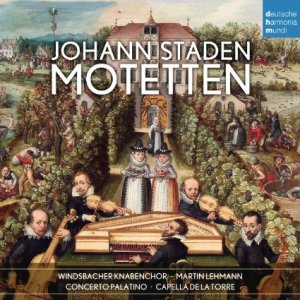Johann Staden (baptized 2 July 1581 – 15 November 1634) He was a distinguished and versatile composer, and one of the outstanding German musicians of his day. In his later years he was the leading musician in Nuremberg and established the so-called Nuremberg school of the 17th century.
Much of Staden’s work survives in printed collections. His first published works were the secular songs of Neue teutsche Lieder (1606), another Neue teutsche Lieder (1609) andVenus Kräntzlein (1610); the songs feature simplistic rhythms, are harmonically simple and feature little to no imitative counterpoint. The same can be said about his sacred songs, which he also published several collections of. Other sacred music is of considerably greater interest: Harmoniae sacrae (1616) contains some of the earliest German sacred concertos, introducing the concepts of an obligatory basso continuo, independent instrumental accompaniment and the solo concerto to Nuremberg’s tradition; these features are also seen in other collections of sacred choral music. The basic style, however, remained that of the motet. Staden’s instrumental music consists of around 200 pieces, including not only various dance forms but also some of the first German instrumental sonatas. These pieces could have been written for a group of performers named Nuremberg Musikkränzlein.
Staden was highly acclaimed as a teacher; he was instrumental in creating the Nuremberg tradition and his most important pupil, Johann Erasmus Kindermann, would carry that tradition through Georg Caspar Wecker and Heinrich Schwemmer to the Krieger brothers and, ultimately, to Johann Pachelbel, who studied under both Wecker and Schwemmer. Other pupils of Staden included three of his sons (Johann, Adam and Sigmund Theophil Staden) and miscellaneous lesser Nuremberg composers. Apart from establishing the so-called Nuremberg school through training young musicians, Staden’s activities in Nuremberg during the 1620s-30s included evaluating new music dedicated to the city (this included Samuel Scheidt’s Geistliche Concerten of 1634). (. “Staden, Johann.” Grove Music Online. Oxford Music Online. Oxford University Press. Web. accessed 15 Nov. 2015. Subscription needed.)
 The world premiere recording of 15 motets of Johann Staden was recently released in April, 2015. The Windsbach Boys Choir was founded in 1946 by Hans Thamm and since 1978 under the direction of Karl-Friedrich Beringer, the choir is one of the most renowned boys choirs of the world, and along with the early music specialists Capella de la Torre and Concerto Palatino this recording has been praised for the “cleanliness and lightness, balance and softness” of it’s sound.
The world premiere recording of 15 motets of Johann Staden was recently released in April, 2015. The Windsbach Boys Choir was founded in 1946 by Hans Thamm and since 1978 under the direction of Karl-Friedrich Beringer, the choir is one of the most renowned boys choirs of the world, and along with the early music specialists Capella de la Torre and Concerto Palatino this recording has been praised for the “cleanliness and lightness, balance and softness” of it’s sound.
The remarkable work of this highly respected composer, organist and music director includes 65 secular and 180 religious works. The resulting 1625 motets combine the polyphonic motet style of the 16th century with the sound splendor of the Venetian polychoral style, or spatially separate choirs singing in alternation

